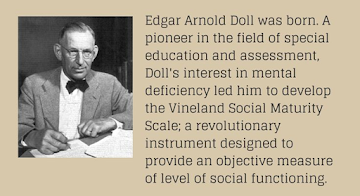Vineland Social Maturity Scale (VSMS) was originally developed by E.A. Doll in 1940, and adapted to the Indian scenario by AJ Malin in 1965. EA Doll named it after the Vineland Training School for the Mentally Retarded, where he developed it. It is a semi-structured assessment based on an interview with the caregiver and evaluates the child’s social ability. The concept of VSMS was built on certain theories of social, and emotional Intelligence.
It
is a questionnaire method that measures adaptive functioning in the context of
self-help skills, self-direction, socialization, and communication.
What it Measures?
1. Communication:
This domain assesses an individual's ability to communicate effectively through
verbal and nonverbal means. It includes skills such as understanding and using
language, expressing needs and wants, and social communication.
2. Daily living skills:
This domain assesses an individual's ability to perform self-help skills, such
as eating, dressing, and hygiene, as well as domestic skills, such as cooking
and cleaning.
3. Socialization: This domain assesses an
individual's ability to interact with others and engage in social activities.
It includes skills such as making friends, initiating and maintaining
conversations, and understanding social cues.
4. Motor
skills: This domain
assesses an individual's ability to perform physical tasks, including gross and
fine motor skills.
The
VSMS measures the differential social capacities of an individual. It provides
an estimate of Social Age (SA) and Social Quotient (SQ) and shows a high
correlation (0.80) with intelligence. It is designed to measure social
maturation in eight social areas:
Ø
Self-help General (SHG),
Ø
Self-help Eating (SHE),
Ø
Self-help Dressing (SHD),
Ø
Self-direction (SD),
Ø
Occupation (OCC),
Ø
Communication (COM),
Ø
Locomotion (LOM), and
Ø
Socialization (SOC).
The
Indian adapted scale consists of 89 test items grouped into year levels. It was
adapted to the Indian setting by A. J. Malin in 1965 and later by Bharat Raj in
1992.
1. Self-help
General (SHG) -
This assesses whether a child can perform general activities on their own, like
head holding, telling what time it is, etc.
2. Self-help
Eating (SHE) -
Assess whether a child handles his/her eating pattern and takes care of their
nutritional needs.
3. Self-help
Dressing (SHD) -
Assess the child’s ability to dress or cleanse themselves.
4. Self-direction
(SD) - This
includes how a child gradually breaks away from authority, followed by the
assumption of responsibility and authority for others.
5. Occupation
(OCC) - This includes playful activities during
infancy, self-exploratory task, etc.
6. Communication
(COM) - Assess the
social usage of language, literacy, and other means of communication.
7. Locomotion
(LOM) - Involves social movements associated with
social responsibilities.
8. Socialization
(SOC) – This
includes a child’s social skills.
Salient Features
ü
It
has eight social domains with 117 items,
ü
Age
range - from 0 to 15 years.
ü
It
is usually administered through the caregiver.
ü
Used
in clinical, teaching, and research settings.
ü
It
has been standardized and practiced in India which has 89 items in 8 domains.
ü
It
is often used to assess intelligence, by proxy, especially when other
standardized intelligence tests cannot be administered.
ü
In
India, VSMS is mandatory to administer to arrive at the level of disability,
for certification as well as for providing disability benefits.
ü
VSMS
is administered for the main purpose of determining the social and adaptive
functions.
ü
Vineland
Social Maturity Scale (VSMS) is generally used to determine three related but
different aspects, which are (i) social and adaptive functions, (ii) level of
disability, and (iii) intelligence.
Recording
Record Sheet is used for
noting the child’s responses. Mark the item pass (+) if the child is able to perform
correctly and fail (-) if otherwise. Half credits may be given if it can be
presumed that the child could have passed the item if the opportunity was
present. These half credits receive full credit if they lie between two passed
items.
Scoring
Add up passed scores (full
and half). Find out the Social Age (SA) from Appendix-11 of the VSMS manual.
Compute Social Quotient (SQ) by dividing SA by CA and multiplying by 100.
Assess maturity levels both in terms of SA and SQ for each of the eight social
areas by referring to VSMS norms and enter in the columns of the social
maturity constellation record.
Psychometric Properties
The reliability of the VSMS
ranged from 0.85 to 0.9. It has good concurrent validity of at least 0.8 with
intelligence tests in children with mental retardations. The maturity age
associated with the level of functioning was calculated along with a social
maturity age that is then converted to an index called the ‘social quotient’
(SQ). The VSMS total score was validated by Roszkowski (1980) who found a
strong correlation of 0.79.
Applications
It is used at least for three different (but
mutually not exclusive) purposes.
Ø
to assess social and adaptive functions, in different domains and to
plan intervention
Ø
to assess the extent of disability, for certification and providing
disability benefits, and
Ø
to assess intelligence
***********






No comments:
Post a Comment